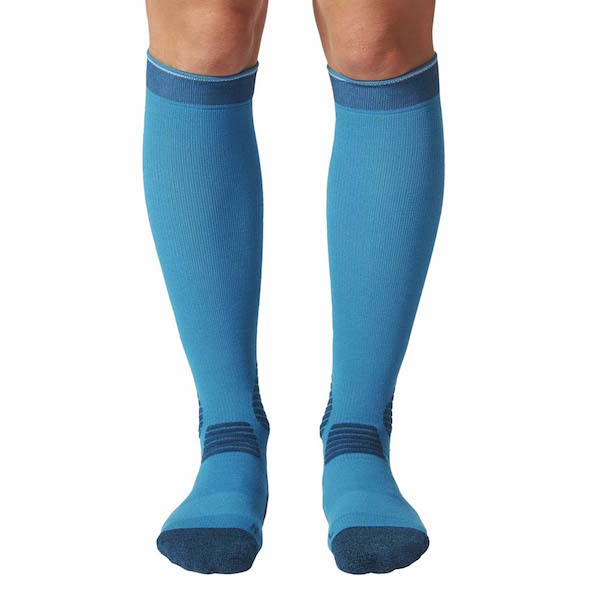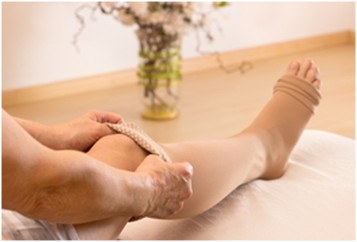Looking for Circulation Socks?
You’re in the right place. We’ll cover circulation basics, then help you pick out a great pair of circulation socks.
How Much Do You Know About Blood Circulation?

Have you ever wondered how blood gets from Point A to Point B in your body? Even more importantly, do you know what happens when blood doesn’t circulate properly? Diagrams like the one to the above may seem intimidating, especially when it has confusing terms, such as “great saphenous vein” and “posterior tibial artery.”
Don’t get scared… You don’t have to be a scientist to understand the circulatory system (I promise!) I will explain everything in everyday language. And, knowing how circulation works can improve your quality of life.
Want to Stop Leg Swelling and Improve Athletic Performance?
ComproGear Compression Socks are designed to stop swelling instantly!
Click the button below to see the lineup of ComproGear Compression Socks:
What is Blood Circulation? Why Does it Matter?

Without blood, your organs would fail. So, different parts of your body cooperate to get blood to your heart (to receive oxygen) and to your organs (to deliver the oxygen it carried.) The main organ in this process is the heart.
Arteries have the job of taking oxygenated blood from your heart to your organs and tissues. Veins take the deoxygenated blood back to your heart to be loaded up with oxygen again.
The most common symptoms of slowed/interrupted circulation are:
- Tingling
- Numbness
- Throbbing or stinging pain in your limbs
- Pain
- Muscle cramps
Such an episode doesn’t necessarily indicate a medical problem. However, if it happens frequently or for no apparent reason, you may have a circulatory issue. Over time, reduced blood flow in your extremities can lead to blood clots or nerve and tissue damage. Both conditions are dangerous.

Blood clots form when the blood circulation at one part of the body is disrupted. Clots make it harder for the blood to flow back to your heart.
If clots get bad enough, they can even stop the distribution of oxygen and nutrients throughout your body. Sometimes, you can see evidence of blood clots on the surface of your skin. They may just look like an ordinary bruise.
You can work to avoid these diseases and health conditions by developing better circulation.
Which part of the body has the highest chance of poor blood circulation, and why?
If you said the legs, you’re right.
Why the legs? If you think about it, other than when you are sleeping, you spend a lot of time using your legs. If you regularly stand or sit for extended periods, you may soon start to suffer from venous reflux disease.
What is venous reflux disease?
Venous reflux disease (also known as venous insufficiency) is a medical condition affecting the circulation of blood in the lower extremities. Normally, one-way valves in the veins keep blood flowing toward the heart against the force of gravity.
If the valves become weak and fail to close properly, they allow blood to flow backward. This reflux of blood can result in a number of clinical problems—edema, skin changes, venous ulcers, and varicose veins, to name a few.
Thankfully, you can improve the circulation in your legs. With compression socks, you can relieve your muscles and promote better blood circulation in your legs and feet.
Are compression socks for you? Here are some important things to know.
Related Articles
- Compression Sleeves for Legs
- Sock Soothers
- Medical Compression Socks
- Best Compression Socks for Swelling
- Compression Socks for Men
- Best Compression Socks for Ankle Swelling
- Can You Wear Compression Stockings 24 Hours a Day
- Wide Calf Compression Socks
- Toeless Compression Socks
- Easy To Put On Compression Socks for Elderly
- Footless Compression Socks
- Do Compression Socks Help Gout
What are Compression Socks?

Though compression socks may look just like regular garments, they have a particular function. These specially-designed garments improve the flow of blood in the legs and feet.
Otherwise known as circulation or support socks, they are produced with synthetic fabrics, so users experience a tight and stretchy fit. The pressure created by the snug material not only helps keep them in place but also encourages blood flow.
Types of Compression Socks

Compression socks come in a variety of styles and lengths. They even come in stocking form, from knee-highs to pantyhose. Knee-high is probably the most popular length; however, doctors may recommend thigh-highs to treat some medical conditions.
Compression socks also differ in the levels of pressure they provide. To find out which type is right for you, you can ask your healthcare professional to measure you for a pair. They should never be painfully tight.
Are compression socks for you?
Anyone who wants to improve their blood circulation, relieve swelling, and give their feet and legs support can wear compression socks and stockings. From young athletes to working-age professionals to the elderly or disabled—you name it.
People of certain professions, such as flight attendants, office workers, teachers, and nurses like to wear compression stockings under their garments at work. Pregnant women, people recovering from surgeries, and those at risk or dealing with diabetes, varicose veins, and deep vein thrombosis (DVT) may wear compression socks as part of their healthcare routine.

What do compression socks do?
Regular socks may provide warmth and protect your feet inside your shoes. Compressions socks put soft pressure on your legs and ankles. The blood vessels thus work more efficiently, and blood flows more freely.
Because blood returning from the lower part of your body has to work against gravity to return to your heart, compression socks can give your arteries a much-needed boost to get that deoxygenated blood where it needs to go.
As a result, these socks reduce aches and fatigue, ease swelling (edema) and help prevent ugly varicose and spider veins. Since compression socks make sure blood is always moving, they also reduce the likelihood of dizziness or blood clots.
Is it reasonable to wear compression socks every day?
For a healthy individual, there’s nothing unusual about wearing compression socks or stockings every day. Some people wear theirs daily.
Others only use them when traveling long distances or when they experience heavy, achy, or restless legs.
However, if you have a medical condition, your doctor will be the best one to advise you how often to wear your socks. Again, the effectiveness of your socks will depend on whether you choose the right level of compression for your lifestyle.
How long should compression socks be worn?
It depends. It is not recommended to sleep in your socks. When you are lying down, your body doesn’t the same fight against gravity. Therefore, you don’t need the amount of pressure that you would if you were standing or sitting. It’s best, then, if you only wear compression socks when you are awake and active.
Most people who use them for work take them off when they get home. If you need to wear your socks for an extended period, you may decide to give your legs a break every couple of hours by taking them off for a few minutes at a time.

Can wearing compression socks be harmful?

Compression socks pose no significant safety risks when they are used correctly.
Everyone who wears compression socks or stockings, including healthy individuals, should choose the right compression rating for their circumstances and follow his or her doctor’s instructions regarding their use.
Nevertheless, you may experience some minor undesirable effects if you wear compression socks. If you experience discomfort or irritation, it’s often a result of wearing socks of the wrong size or pressure level.
What to consider when buying compression socks and compression stockings
Here are some things you need to consider when looking for the right compression socks to buy:
- Quality: Ensure your socks are made of good quality material before making your purchase. The fabric should be elastic enough to compress your legs properly. Compression socks made with inferior materials can cause itching and skin irritation.
- Compression level: Compression is the most important criterion. You can select socks based on four main categories of mmHg ( a unit of measurement for pressure): 8-15 mmHg (Low/Mild), 15-20 mmHg (Moderate), 20-30 mmHg (Firm) and 30-40 mmHg (Extra Firm). The higher the mmHg, the greater the pressure. The right one for you depends on your health conditions and what you are trying to achieve.
- Fit: Don’t compromise on the fit of your compression socks. It matters! The socks shouldn’t be too tight or loose. It sounds obvious, but knee-high socks should reach your knee. Opt for socks that correspond with the size of your body.
- Style: Compression sock styles differ based on the look and the function. For instance, those experiencing swelling in the ankles may choose to wear an ankle-length sock style. Those suffering from leg and joint pain may prefer thigh-high socks. Pregnant women may prefer support hose or specially-fitted stockings.
To sum it up…
The importance of good blood circulation cannot be underestimated. A well-chosen pair of compression socks can help you never have to deal with varicose veins or some of the other health problems that result from poor circulation. Compression socks are a small monetary investment, yet can provide great health benefits when used right.
This page last updated December 14, 2022
